 General Accounting
General Accounting



This chapter describes the general accounting features of MARS. It contains the following topics.
General accounting involves entering accounting documents into MARS, processing those documents to update the ledgers, customizing ledger inquiries to meet informational needs, and setting account balance and fund balance controls.
General accounting information is entered into MARS through journal vouchers and payroll vouchers. Journal vouchers are used to record accounting transactions and the offsets created by each transaction. Payroll vouchers are used to record summary level payroll accounting information. Payroll vouchers are not meant to provide detail reporting on labor distribution; that function must be provided by a payroll system.
Transactions recorded into journal and payroll vouchers are used to update the online general ledgers: the Online General Ledger and the Real Time Online General Ledger. Each ledger provides general accounting information. This standard information can be customized to meet your site's specific general accounting needs; for example, the program that loads the Online General Ledger can be modified.
Finally, system controls can standardize your general accounting functions. The Account Balance option can be set to carry account balances forward year after year automatically, and the Fund Balance option can be set to track a running balance of unobligated amounts; therefore, these controls facilitate the general accounting process.
This chapter provides instructions for completing each general accounting activity effectively.
The following terms are used throughout this chapter. A definition of each term is provided below. Then, in the remainder of this chapter, each term is covered in more detail.
There are three types of Journal Voucher in MARS; The Journal Voucher Master (JVM), Journal Voucher Transfer (JVT), and Journal Voucher Correction (JVC). They are discussed in detail in the User's Reference . Journal vouchers record accounting events that cannot be recorded on any other MARS document; they can be used to close accounts, move money, adjust balances. In some instances, the journal voucher is used to record adjustments to previously entered transactions. In other instances, such functions are recorded as modification actions using the same transaction type that was used for the original transaction. For example, to adjust a previously entered purchase order, you would simply modify that purchase order.
The journal voucher is not used to clear previous documents. For example, a payment voucher may reference a purchase order and clear the encumbrance created by the purchase order. A journal voucher would never be used for this purpose. In addition, the following Balance Sheet Account codes may not be used on journal vouchers:
- System-wide pre-encumbrance account
- System-wide encumbrance account (see note below)
- System-wide billed receivables account
- System-wide vouchers payable account
These accounts are recorded in System Special Accounts (SPEC). Documents that affect the above balance sheet accounts are entered on the requisition, purchase order, invoice, and payment voucher documents.
- Journal vouchers can be used to post payroll encumbrances to the Reserve for Encumbrance-Payroll account and the Reserve for Encumbrance account. The Reserve for Encumbrance account can be used to encumber payroll funds only if the same Balance Sheet Account number is used to define both the Reserve for Encumbrance account and Reserve for Encumbrance-Payroll on the Miscellaneous view of System Special Accounts (SPEC).
Journal vouchers, however, post to the General Ledger and not to the Open Purchase Order Ledger. Therefore, posting payroll encumbrances to Reserve for Encumbrance creates a mismatch between the General Ledger and the Open Purchase Order Ledger (for that account). Payroll Encumbrance coding is discussed later in this chapter.
Because of the varied uses of the journal voucher, coding instructions for the journal voucher are presented differently than the coding instructions for other documents discussed in this manual. General coding instructions for the header portion of the journal voucher are provided in the User's Reference . Instructions for entering detailed journal voucher lines are covered in the remainder of this chapter. The following topics are covered:
- Reclassifying ledger entries
- Balance sheet transactions
- Expensing previously recorded expenditures
- Standard accruals and reversals
- Posting payroll encumbrances
Entering the line portion of the journal voucher document depends on the type of account you are entering. The following sections discuss the line portion of the journal voucher document in more detail.
The Journal Voucher Correction (JVC) document is used to change the account distribution codes on a previously entered revenue or expense transaction. This includes breaking down a summary transaction into more detailed transactions and changing codes on any general ledger entry (this includes changing lines that were deleted from open item tables because, for example, they are no longer available for adjustment actions on other accounting documents.)
Remember that you cannot use the following four system default balance sheet accounts (as defined on the Miscellaneous View of System Special Accounts (SPEC)) on the journal voucher document:
- Pre-Encumbrance Account
- Encumbrance Account (also obligates payroll encumbrances)
- Vouchers Payable Account
- Billed Receivables Account
If you want to reclassify documents that affect those accounts, use the appropriate document; for example, requisition, purchase order, payment voucher, or invoice. Cancel the document to be reclassified, and code the reclassifications.
In all cases but the baseline Purchase Order (PO), these steps can be done on the same document. The purchase order document does not include a Balance Sheet Account field, so the documents affecting any balance sheet account besides the default encumbrance account have to be entered on a Journal Voucher Master (JVM) document.
To code a reclassification on a journal voucher:
- Enter the header as described above.
- Enter one line on the journal voucher to zero out the existing line (using the codes of the line to be changed, including the Account Type) . The codes must be entered exactly as they appear on the transaction being reclassified. Enter the amount on the Credit side if you are reclassifying an expense document, and on the Debit side if you are reclassifying a revenue document).
- Enter as many new lines as you want to balance the canceled line. Select the same Account Type that was used on the canceled line. Fill in the remainder of the top part of the journal voucher line using new codes, if desired. All codes used must be valid in MARS tables.
- Follow the coding instructions for the document type you are creating, which is the same as the document type you canceled. Enter amounts on the Debit side if you are reclassifying expense documents and on the Credit side if you are reclassifying revenue transactions.
The Journal Voucher Master (JVM) shown in Figure 78 and Figure 79 illustrates a journal voucher coded to break down a summary cash receipt line for taxes into various types of taxes.
Journal Voucher Master (JVM) Document (Receipt Breakdown, Line 1)
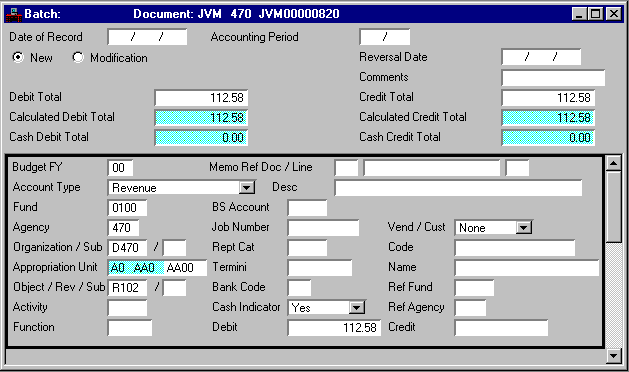
Journal Voucher Master (JVM) Document (Receipt Breakdown, Line 2)
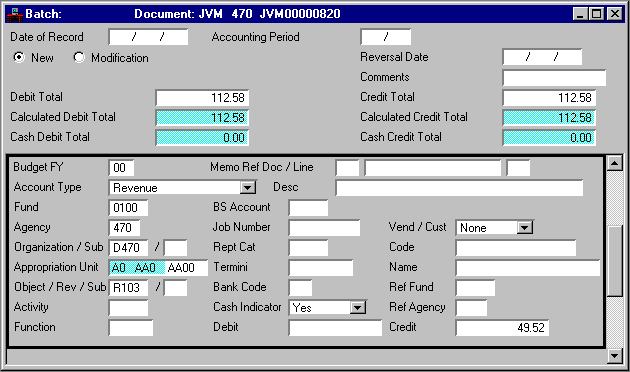
The journal voucher master (JVM) document is the only way to record the earning of a cash advance. To code this type of document:
- Enter the header according to the instructions provided above.
- Enter the debit line with an Account Type of Liability (02), Fund, Agency, Organization, Program Budget Unit , and the Balance Sheet Account (from the cash receipt that recorded the advance receipts.)
- Enter the credit line with an Account Type of Revenue (31) , and the desired account distribution for the revenue received. Enter at least Fund, Agency, Organization, Program Budget Unit and Revenue Source . Balance Sheet Account is blank.
The journal voucher in Figure 80 and Figure 81 illustrates a journal voucher document entered to record a cash advance earned.
Journal Voucher Master (JVM) Document (Cash Advance Earned, Line 1)
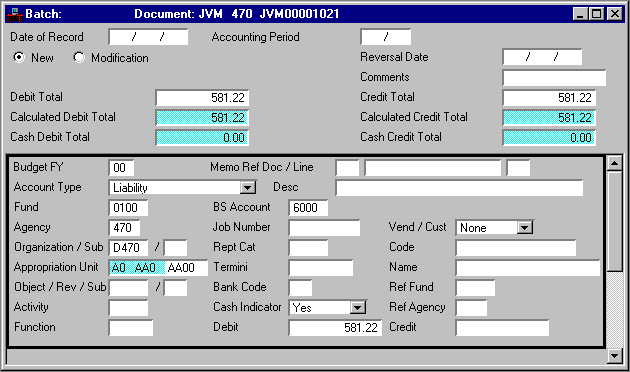
Journal Voucher Master (JVM) Document (Cash Advance Earned, Line 2)
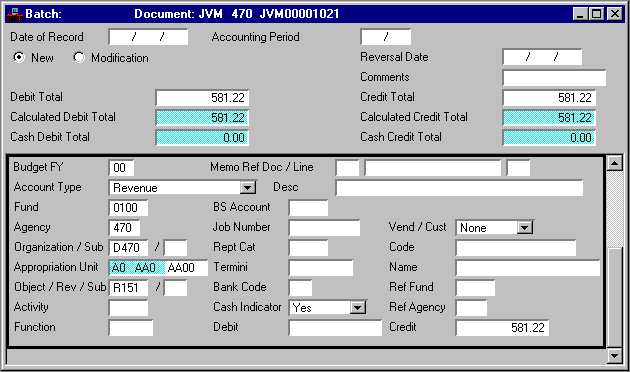
Expensing Previously Recorded Expenditures (Recurring Accruals, Depreciation)
The journal voucher master (JVM) expenses inventoried items, capitalized assets, and prepaid items. In MARS, recurring expenses are handled the same as one-time expenses; a document for a recurring expense is submitted in each accounting period that an expense is to occur. The lines recording the expense are always the same; only the dates in the header differ.
To expense previous expenditures (expenditures are submitted to MARS on payment vouchers or manual warrants), enter the following:
- Enter the header according to the discussion on journal voucher headers above.
- Enter the new ledger line using an appropriate Balance Sheet Account, Fund, Agency, Organization, and Program Budget Unit ; use an Account Type of Asset Offset to Expenses ; this is usually the credit line.
- Enter the offsetting line with an Account Type of Expense and a blank Balance Sheet Account . Enter the Object , Fund , Agency, Organization, and Program Budget Unit ; these codes should match the codes used on the payment voucher or manual warrant that recorded the expenditure. This is probably the debit line.
The journal voucher in Figure 82 and Figure 83 illustrates a journal voucher entered to reflect the expensing of a prepaid rent item.
Journal Voucher Master (JVM) Document (Expense Prior Expenditure, Line 1)
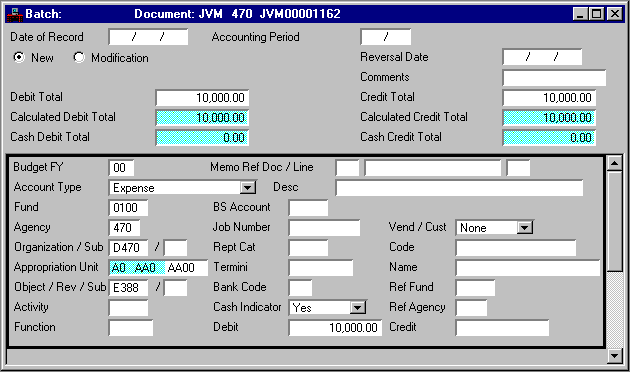
Journal Voucher Master (JVM) Document (Expense Prior Expenditure, Line 2)
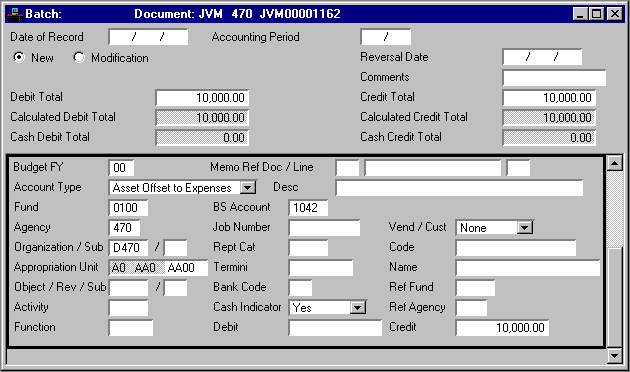
The journal voucher master (JVM) can be used to post payroll encumbrances to two special accounts, the Reserve for Encumbrance-Payroll account and the Reserve for Encumbrance account.
To record payroll encumbrances:
- Enter the header according to the discussion on journal voucher headers above.
- Enter the new ledger entry with an Account Type of Encumbrance (21) . Enter the appropriate Fund , Agency , Organization , Program Budget Unit, and Object . Blank out the Balance Sheet Account field. Enter the Debit Amount .
- Enter the balancing line with an Account Type of Fund Balance (03) . Enter the appropriate Reserve for Encumbrance-Payroll account. This account is defined on System Special Accounts (SPEC). The Reserve for Encumbrance-Payroll account must be a valid balance sheet account and cannot equal any other special account except the Reserve for Encumbrance account. See Journal Vouchers for information on the accounting implications of using the Reserve for Encumbrance account as the Reserve for Encumbrance - Payroll account. Enter the Credit Amount.
- Select the Journal Voucher Payroll Encumbrance indicator on System Control Options (2 of 2) (SOP2). The Related to Payroll indicator on Object (OBJ2) must also be selected.
Changes to the encumbered amount are reflected on the following accounting windows: Expense Budget Inquiry (Extended) (EEX2), Appropriation Inquiry (Extended) (EAP2), and Allotment Inquiry (Extended) (EALL). When a journal voucher references a grant, changes to the encumbered amount occur on the following windows: Agency Project Inquiry (AGPR), Project Budget Line Inquiry (1 of 2) (PRBL), Project Budget Line Inquiry (2 of 2) (PRB2), and Project Fiscal Year Inquiry (PFYT).
Changes to the Reserve for Encumbrance-Payroll Account Balance and to the Fund used on a journal voucher are found on Balance Sheet Account Balance (BBAL) and Fund Balance (FBAL).
The net amount on the batch ticket should be zero for all batches of journal voucher documents. This is because the debit total and credit total on each journal voucher document must balance out to zero.
Lines on a journal voucher document reflect assets, liabilities, revenues, expenses, or encumbrances. Each of these requires a different processing procedure within MARS. The Account Type code on Account Type (ACCT) identifies the type of document being recorded, and is required on all journal voucher lines. The Journal Voucher Correction (JVC) and Journal Voucher Transfer (JVT) do not require an account type to be selected, but rather infer the account type for each line from other coded attributes.
Valid Account Type codes and descriptions are listed below. Although you use only the descriptions while completing the journal voucher document, the corresponding codes are used on other windows.
Most expenditure transactions have an Account Type Expense/Expenditure (22) . The Account Type Asset Offset to Expenses (11) is generally used for depreciation of fixed assets. The Account Type Encumbrance (21) may be used to obligate payroll funds. See The Chart of Accounts for additional information about Account Type codes. See Expenditure Accounting for further explanation concerning the three expenditure account types.
The Vendor/Provider Code field on the line level of the Journal Voucher Master (JVM) document is used by MARS to validate the vendor or provider in the corresponding table. When the code is Vendor , the line amount is posted to the year-to-date amount fields for the vendor on Vendor (VEN2). This can be useful for corrections to 1099 vendors. The Vendor/Provider field on the journal voucher indicates whether the code is for an existing vendor as defined on Vendor (VEN2) or an existing provider as defined on Customer (CUST); valid values are Vendor , Provider , Quantity , and None .
Standard Accruals and Reversals
The journal voucher allows you to record month-end accruals and reverse those documents in the new accounting period. Remember that the system-wide pre-encumbrance, encumbrance (except when posting payroll encumbrances), billed receivables, and vouchers payable accounts cannot be used as the Balance Sheet Account.
Logic Tests on Journal Voucher Amounts
The entire journal voucher document must be self-balancing; the debit document total and the credit document total must be equal. Also, no line can contain a credit and a debit amount; the balancing must occur in a series of separate, offsetting entries.
The following controls operate on the Debit and Credit Total fields.
If Expense Budget Full control (on Fund (FUN2)) is in effect, a debit line amount cannot exceed the unobligated budget amount. If Allotment Full control is in effect, a debit line amount cannot exceed the unobligated allotment amount. If the expenditure line consists of a credit, warning messages are printed if the amount exceeds either the obligated budget amount or the obligated allotment amount, that is, if total obligations are decreased below zero.
If a debit amount (reduction in revenue) exceeds the revenue amount recognized on revenue budget tables to date, then a warning message is produced. Similarly, if a reduction in revenue (debit) exceeds the cash already collected for the budget distribution, then a warning message is produced.
For a Selling Fund Asset Account Line Adjusting a Previous Payment Voucher
A debit amount cannot be greater than the closed receivable amount recorded for the voucher, and a credit amount cannot be greater than the outstanding receivable voucher amount.
For a Buying Fund Liability Account Line Adjusting a Previous Payment Voucher
A debit amount cannot exceed the outstanding payable amount, while a credit cannot exceed the closed voucher amount.
Document Control Inquiry (DCTL) tracks journal voucher transaction IDs used within an accounting period. It also tracks cash receipts, payroll vouchers, and manual warrants. One line exists in the document control inquiry for each journal voucher document accepted by the system, for all open accounting periods. The line contains only the Accounting Period , the Transaction Code , Transaction Number , and the Date of Record .
The purpose of Document Control Inquiry (DCTL) is to prevent the use of duplicate Transaction IDs within an accounting period. Accounting Period is a key in the window. Therefore, you can use a scheme for assigning document numbers that revises the same numbers, but in different accounting periods. A Transaction ID can be reused in the accounting period by selecting the Modification indicator.
The monthly clearing process clears all lines in Document Control Inquiry (DCTL) associated with the accounting period being closed.
Payroll Voucher (PR) Documents
The payroll voucher (PR) document lets you record payroll-related expenditures in the General Ledger that were previously distributed. The accrual of liabilities may also be recorded, but the payroll voucher does not lead to actual disbursements. (That function is generally accomplished with your payroll system.)
Amounts recorded in the general ledger reflect:
- Gross payroll expenses (labor distribution is reported with codes)
- Gross to net distribution of liabilities (payroll deductions such as taxes, FICA, credit union)
- Net payroll cash outlay (total amount of payroll checks)
Since the payroll voucher (PR) is not a part of the MARS disbursement process, payroll voucher documents do not appear in any open item tables or ledgers. The expenditures and the liabilities recorded on payroll documents are reflected in the appropriate budgetary balances in the budget master tables.
Accounting for payroll expenditures involves two steps:
- The accrual of payroll (labor distribution) expenditures and associated payroll liabilities
- The payroll disbursement
Often both steps are combined in a single document, in which labor distribution expenditures are offset by credits to cash and various payroll withholding and MARS gives you the flexibility of using either approach.
All payroll voucher expense lines are subject to the same controls as all other expenditure accounting documents. That is, payroll voucher documents are rejected on the basis of edits against budgeted amounts, appropriated amounts, allotted amounts, and a minimum required fund balance, if any of these controls are in effect for the fund recorded on the payroll voucher document. You can see whether any of these controls are in effect for a particular fund by looking at the Control Options view of Fund (FUN2). These controls include:
For more information on these options, See System Controls and Options.
Payroll Voucher (PR) Instructions
Two types of line entries may be recorded on a payroll voucher (PR) document:
- Expense lines report all expenditure amounts associated with payroll accounting. Separate lines are used to put labor expenditures into appropriate accounting distributions (agency, organization, etc.). The total of these lines represents gross pay (the total amount obligated for payroll purposes by the payroll voucher document).
- Liability lines report all liability amounts associated with payroll deductions. Separate lines are used to distribute the liability among the proper balance sheet accounts. The total of these lines represents gross to net (the total amount obligated for deductions by the payroll voucher form).
All Amount fields are entered as absolute values (no signs). Both the expense and liability line types have Default/Increase/Decrease indicators to indicate whether the line amount is added to or subtracted from the fund balance or balance sheet account balance. For more information, see the User's Reference .
Default/Increase/Decrease Indicators
For expense lines, the selected Default/Increase/Decrease indicator is Def [blank] (default) or Inc [I] (increase) for new lines and increase adjustments. To code the decrease adjustment, select Dec [D] (decrease).
For liability lines, the Default/Increase/Decrease indicator is Def [blank] or Dec [D] for new lines and increase adjustments. (This coding preserves expenditure accounting consistency in MARS, with Dec [D] generating a credit.) To code the decrease adjustment, select Inc [I] .
The net payroll cash amount is a control figure used to ensure that the other two document totals (total gross pay and total gross to net) reflect balanced entries. It usually is the total cash outlay (total amount of paychecks) represented by the payroll voucher document. In some cases, it may reflect an amount owed to the entity.
The net payroll cash amount is the total gross pay minus the total gross to net. Each of these totals is the difference between the increases and the decreases. (Remember that Dec [D] in an expense line is a minus value, while Inc [I] in a liability line is a minus value.) Use the signed totals when computing the net payroll cash amount, even though all amounts recorded on the document remain unsigned. The following illustrates sample Payroll Voucher Amount computations.
Payroll Voucher Amount Calculations
Example 1. This is an example of the most common situation. All expense lines are I s and all liability lines are D s. The net payroll cash amount represents the total cash outlay reflected on the payroll voucher document and is computed as follows:
(+) 7852.55
minus (+) 1923.05
5929.50
Example 2. This example illustrates a case where past deductions were too large. The net payroll cash amount represents the total cash outlay reflected on the payroll voucher document and is computed as follows:
Example 3. This example illustrates a case where past deductions were too small. The net payroll cash amount is computed as follows:
Example 4. This example illustrates a case where personnel were overpaid and past deductions were too small. The net payroll cash amount is computed as follows:
Object codes used on the expense lines are personal service objects. That is, the Related to Payroll option on Object (OBJ2) is selected for any object used on payroll documents. Otherwise, the document is rejected.
Interfacing Labor Disbursements to MARS
If your installation has an automated payroll disbursement system, it may be possible to write interface programs to transfer the data from that system into the MARS ledgers. The resultant data can then be input directly to MARS through the offline mode of operation. This procedure eliminates user participation in the payroll expenditure process (no documents have to be entered or data entered online for the expenditures and liabilities to be reflected in the financial system's General Ledger).
Accounting Model and the Ledger
Payroll voucher lines are posted to the Current Detail General Ledger in the following manner:
Dr Expense (labor distribution expenditures)
Cr Balance Sheet Account (withholding and deductions)
The amount posted is the line amount from the payroll voucher document. The following illustrates the accounting model for payroll voucher documents.
Accounting Model for Payroll Voucher Documents
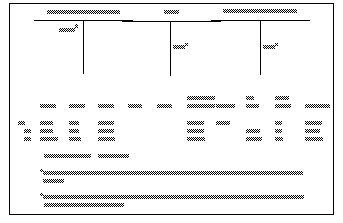
The monthly table clearing process clears all lines on Document Control Inquiry (DCTL) associated with the accounting period being closed.
Document Control Inquiry (DCTL) tracks payroll voucher Transaction IDs used within an accounting period. (Document Control Inquiry (DCTL) also tracks cash receipts, journal vouchers, and manual warrants.) One line exists in Document Control Inquiry (DCTL) for each payroll voucher document accepted by the system, for all open accounting periods. The line contains only the Accounting Period, the Transaction Code, Transaction Number, and the Date of Record. The purpose of Document Control Inquiry (DCTL) is to prevent the use of duplicate IDs within an accounting period. Accounting Period is a key in the table. Therefore, you can use a scheme for assigning document numbers that reuses the same numbers, but in different accounting periods.
General Accounting - Special Features
Recurring Journal Voucher Masters
The recurring journal voucher master (JVM) capability of MARS automatically generates documents on a monthly, bimonthly, or quarterly (beginning or end) basis, using data that users previously entered in a window. The information is entered only once, along with starting and ending dates and an indicator controlling how often the document should be generated. An offline program run by the computer operations personnel generates the documents and adds them to the Document Listing (SUSF). Users then access the transactions, change them if desired, and process them. This facility is useful for processing specific month-end adjustments.
New information or modified data is entered in Recurring Journal Voucher Master (RJVM). During data entry, data is validated (codes are validated against the entry Start Date and Fiscal Year ), however, no validations are made against the budget tables. A comprehensive validation of data entered occurs when the documents are added to the Document Listing (SUSF) and processed by the journal voucher document processor. For more information on Recurring Journal Voucher Master (RJVM), see the User's Reference .
When entering data into Recurring Journal Voucher Master (RJVM), note that the Debit Amount and Credit Amount fields can be blank. The user may not know the exact line amount when the recurring information is being entered. If the amount is not entered, the system places the words fill-in the Credit Amount field to serve as a reminder that an amount is still required. You may enter the missing amount in Recurring Journal Voucher Master (RJVM) at a later time, or wait until the document is added to the Document Listing (SUSF) and change it there.
The Frequency field on Recurring Journal Voucher Master (RJVM) indicates how often the document is generated. The valid values for the transactions are:
- One-Time Future transaction
- Monthly transaction
- Bi-Monthly transaction (every other month)
- Quarterly transaction
- End of Quarter transaction (last month of quarter)
Your computer operations personnel runs the recurring journal voucher master offline program once a month. See the System Administration Guide for a list of the parameters required by the programs.
The generated documents have the following accounting periods:
- If the Current Accounting Period and Budget Fiscal Year parameters are provided in Recurring Journal Voucher Master (RJVM) entry for the offline programs, those values are used on the generated documents
- If the Application Dates (LDAT) parameters are blank, those fields are blank on the generated documents, and is inferred from the document's Transaction Date by the journal voucher document processor. The transaction date on the generated documents is the date when the program was run (run date).
The To-Date parameter determines whether particular entries in the table should be selected for document generation:
- If the From-Date on the entry is after the To-Date , the entry is not selected.
- If the From-Date on the entry is before the To-Date , the entry is not selected (it is deleted).
- The program compares the entry's Last Date field on Recurring Journal Voucher Master (RJVM) and the To-Date parameter on Application Dates (LDAT) and determines whether it is time to generate another document for the entry.
The To-Date parameter on Application Dates (LDAT) is also used for the following purposes:
- It becomes the Last Date field on Recurring Journal Voucher Master (RJVM) for selected entries.
- It becomes the Batch Date and Transaction Date for the generated journal voucher master documents.
- If the recurring table entry's End-Date is before or equal to the To-Date , the entry is deleted.
The recurring journal voucher master documents are not batched. The Transaction IDs are composed of the following pieces:
- Transaction Code.
- Submitting agency. The submitting agency from the Recurring Journal Voucher Master (RJVM) entry.
- Document number. The Journal Voucher Number from the Recurring Journal Voucher Master (RJVM) entry (9 digits) followed by the To-Date month from the document's Application Dates (LDAT) entry. Blanks default to zeros. Documents exist in the Document Listing (SUSF) in a scheduled for offline processing status.
Recurring Journal Vouchers Selection Examples
The following figure shows the relationship between the various dates in the selection process for recurring journal vouchers. Y in the Select column indicates that a document was generated and added to the Document Listing (SUSF). Y in the Delete column indicates that the entry in Recurring Journal Voucher Master (RJVM) was deleted.
(*) When the ending date equals the to-date, the entry is selected (for example, a document is generated for it) and then immediately deleted. However, when the ending date is after the current to-date (but before the next run's to-date), the entry is not deleted immediately.
(**) A frequency of Q means once per quarter, not every three months. Thus, the entry would not be selected for two succeeding months. It is not selected again until the to-date is 04-01-00.
(***) A frequency of E means third month of each quarter. The above example for E assumes that 1/1/00 is the first month of a fiscal quarter and 3/1/00 is the third month of the same quarter. This entry would be selected again on 6/1/00, 9/1/00 and 12/1/00 and would then be deleted on 12/1/00.
Automated Journal Voucher Reversal Process
Journal vouchers can be used to record documents that should be automatically reversed at a later date. To create journal voucher reversal documents, follow these guidelines:
- The journal voucher document number must contain an E in the last position.
- The Reversal Date is the date on or after when the amounts are to be automatically reversed. The date must be a valid date, greater than the transaction date.
The documents that you code are processed as usual. Then offline programs create the reversal documents on or after the reversal date. The reversal documents are added to the Document Listing (SUSF), scheduled for offline processing. The reversed documents look like the original documents, except:
- The Reversal Date becomes the transaction date of the reversal document
- The Reversal Date field is blank
- The Accounting Period is blank
- The last character of the document number is changed from E to R (The system creates the reversing entry and changes the E to an R )
- The Debit and Credit amounts are switched on each line.
In order to facilitate the use of the Automated Journal Voucher Reversal Process, your computer operations personnel must adjust the programs being executed in the nightly cycle processing. The Archive and Create JVM Reversals (RECJ) program, should be permanently substituted for the Archive (ARCH) program.
Online Balance Sheet Account Balances
MARS can provide online access to the current balance of a balance sheet account. This capability is controlled through the Account Balance field on the Control Options view of Fund (FUN2). When activated, this option makes all balance sheet account balances within the fund(s) for which it is selected available. These balances are stored in Balance Sheet Account Balance (BBAL), where they are available for online inquiry or a hardcopy report.
The Account Balance is selected by fund on the Control Options view on Fund (FUN2). The valid value of Y (Yes) selects the option (initial account balances must then be input into Balance Sheet Account Balance (BBAL) for accounts within the fund), while N (No) rejects the option.
For more information on Balance Sheet Account Balance (BBAL), see the User's Reference .
MARS also provides the capability to access fund balances through online inquiry. This capability is controlled by the Fund Balance option on the Control Options view of Fund (FUN2). When selected, the option allows a minimum dollar amount to be specified that must be maintained in a fund. Documents are rejected when they cause the fund to go below this minimum amount. MARS keeps a running balance of unobligated amounts for funds that select this option. This current fund balance is stored in Memo Actual Fund Balance field in Fund Balance (FBAL) where it is available for online inquiry or a hardcopy report. The minimum fund balances desired for the funds are also specified in Fund Balance (FBAL).
The Fund Balance option is selected by fund in the Control Options view on Fund (FUN2). The valid values are:
- Select . Selects the fund balance option for a fund (a line must then be added to Fund Balance (FBAL) to record the minimum and beginning balances)
- Reject . Rejects the fund balance option.
- N/A . This option is not applicable.
Initial fund balances are input into the system online when the Fund Balance option is selected for the first time for a fund. Thereafter, the system automatically carries forward the current balance from year to year.
Your installation may maintain an online version of the General Ledger that can be accessed on your workstation just like other windows. Documents are displayed on the window sorted by Fiscal Year, Accounting Distribution, Account Type, Sub-Organization, Sub-Object/Revenue Source, Job Number, Project, Reporting Category, Termini, Transaction Date, Fiscal Month, and Document ID.
The Online General Ledger allows you to easily research all document activity against a specific account. Opening and closing balances are displayed for each account. Detail debit and credit balances, as well as summary open balances and total balances, are also displayed for each fund and each fiscal year.
The opening balance is the account balance for all accounting periods that were summarized on the online General Ledger. Detail no longer exists on the file supporting the opening balance. The summary open balance is the sum of all the opening balances for a fund or fiscal year. It should equal zero. If the online General Ledger has not been summarized during the current year, then an opening balance and a summary open balance are not displayed.
The closing balance is the current account balance, reflecting the opening balance and all detail existing for the account. Detail records are added to the online General Ledger daily, as part of the daily offline processing cycle run by your computer operations personnel every night.
The detail debit/credit balance is the sum of all the debit/credit for a fund and/or fiscal year. The debit amount should equal the credit amount. The total balance is the sum of all the debit and credits for a fund and/or fiscal year. This balance should equal zero.
Loading the Online General Ledger
MARS package is delivered with a single program that will perform the original load of the Online General Ledger (LOD1) and the daily load of the Daily General Ledger records (OLGL).
Summarizing the Online General Ledger
The Online General Ledger can be summarized, by accounting period, at any time. Since the process does not depend on the offline files or on monthly closing, your online General Ledger may contain detail for closed accounting periods. It could even maintain detail for the entire year, if your system has enough disk space to support it.
Summarization of the Online General Ledger is performed by the Online General Ledger Summarization (OLCL) program. See the System Administration Guide for a list of the required parameters. Figure 86 and Figure 87 show samples of the Online General Ledger Inquiry windows.
Online General Ledger Inquiry (1 of 2) (OLGL)
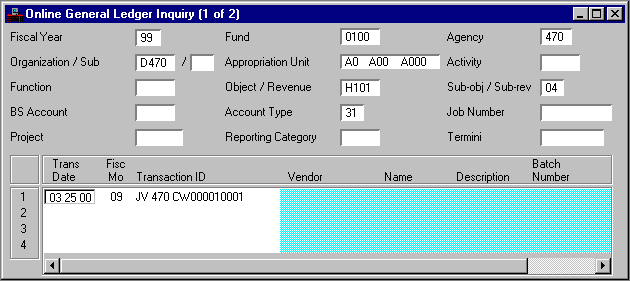
Online General Ledger Inquiry (2 of 2) (OLG2)
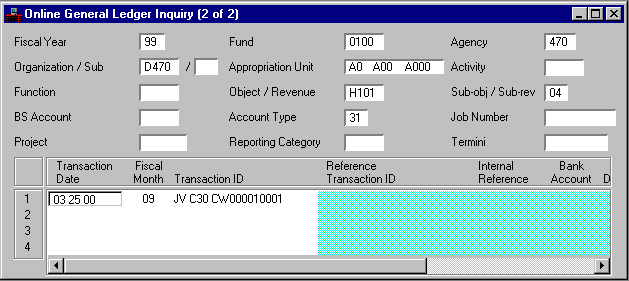
Purging the Online General Ledger
To make space for new years, you can purge the Online General Ledger records by a selected fiscal year. To purge an old year from the table, the purge year must be supplied. This process to perform this purge is the Purging of Online General Ledger (OLPL) program. See the System Administration Guide for a list of the required parameters.
Real Time Online General Ledger
In addition to the batch-oriented online general ledger and flexible ledger capabilities, MARS provides a Real Time Online General Ledger. This ledger provides the capability to record and track detail general ledger activity on a real time, online basis. Whenever ledger entries are posted by a program (this includes online document processors as well as any offline processing programs), those ledger records are concurrently and automatically posted to the Real Time General Ledger. Therefore, ledger detail is available online immediately without waiting for the offline update process.
Through the Update Real Time Ledger option on System Control Options (2 of 2) (SOP2), an installation may choose to use or disable the Real Time General Ledger. To utilize the real time ledger capability, the indicator must be selected.
For more information on Realtime Online General Ledger Inquiry (LDGR and LDG2), see the User's Reference .
The Expense Budget Detail window (EEXD) displays the budget lines in your system and the transactions affecting them. You can use this window to verify pre-encumbrances, encumbrances, and expenses for each budget.
The Expense Budget Load program (EXPL) adds all of the expenditure transactions into Expense Budget Detail (EEXD). Only transactions affecting Expense Budget (EEX2) are loaded into the Expense Budget Detail windows. The Expense Budget Detail Clear program (EXPC) takes detail information and produces summarized records on Expense Budget Detail (EEXD). It may summarize one or several accounting periods at a time. Additionally, the Expense Detail Purge program (EXPP) is available to purge data by fiscal year.
For more information on these programs, see the System Administration Guide .